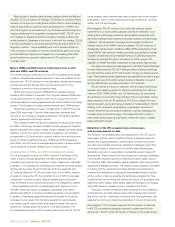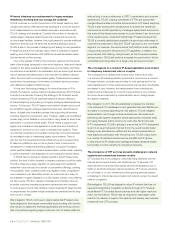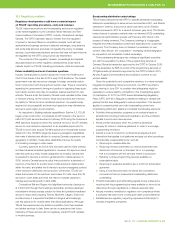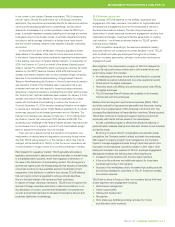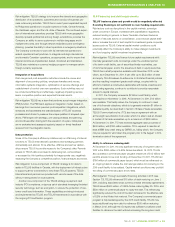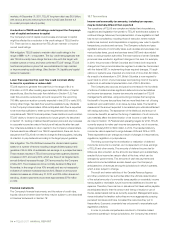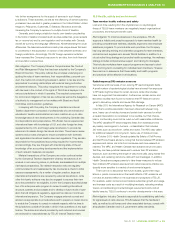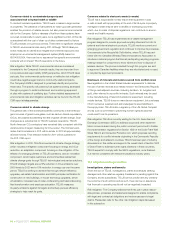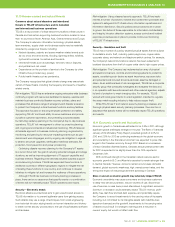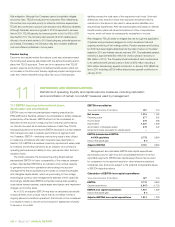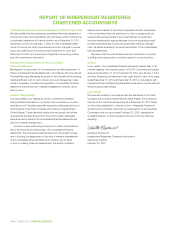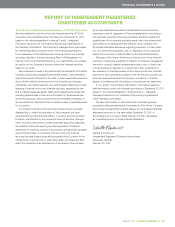Telus 2011 Annual Report Download - page 100
Download and view the complete annual report
Please find page 100 of the 2011 Telus annual report below. You can navigate through the pages in the report by either clicking on the pages listed below, or by using the keyword search tool below to find specific information within the annual report.
96 . TELUS 2011 ANNUAL REPORT
Concerns related to contaminated property and
associated risk to human health or wildlife
To conduct business operations, TELUS owns or leases a large number
of properties. The presence of fuel systems for back-up power generation
enables the provision of reliable service, but also poses an environmental
risk for the Company. Spills or releases of fuel from these systems have
occurred occasionally in recent years, but a significant portion of this risk
is associated with the cost of clean-up of sites contaminated by historic
TELUS practices or by previous owners. There were no significant changes
to TELUS’ environmental risks during 2011. Although TELUS takes pro-
active measures to identify and mitigate environmental exposures and
employs an environmental management system (EMS) based on
ISO14001:2004, there can be no assurance that specific environmental
incidents will not impact TELUS operations in the future.
Risk mitigation: While TELUS’ environmental risks are considered
immaterial to the Company’s financial results, they are important from
a corporate social responsibility (CSR) perspective, which TELUS takes
seriously. Poor environmental performance or ineffective risk mitigation
could have negative legal, brand or community relations impacts.
The Company’s EMS is designed to proactively identify and prioritize
these risks. The specific risk posed by fuel systems is being addressed
through a program to install containment and monitoring equipment
at sites with systems of qualifying size. Further detailed assessment of
environmental risks and mitigation activities can be found in the TELUS
CSR report at telus.com/csr.
Concerns related to climate change
The general view of the worldwide scientific community is that anthropo-
genic sources of greenhouse gases, such as carbon dioxide equivalency
(CO2e), are possibly accelerating the rate of global climate change. Such
changes are a potential risk to TELUS’ business operations. TELUS’
North American CO2e emissions have remained fairly consistent with little
variance since it began measuring its CO2e
output. The Company esti-
mates that its emissions in 2011 will be similar
to 2010 at approximately
350,000 tonnes. Final emission totals for
2011 will be published in
the 2011 CSR report.
Risk mitigation: In 2010, TELUS announced its climate change strategy,
which includes a mitigation component focusing on energy and CO2e
reduction, an adaptation component focusing on the mitigation of the
effects of a changing climate on TELUS operations, and an innovation
component, which helps customers and communities realize their
climate change goals through TELUS’ technological and service solutions.
TELUS’ strategic targets are a 25% reduction in CO2e emissions over
2009 levels by 2020 and a 10% reduction in energy use over the same
period. TELUS is working to achieve this through network efficiency
upgrades, real estate transformation and LEED principles certification for
construction of new buildings, in-house technology upgrades, server
virtualization, increased use of video-conferencing and teleconferencing,
fleet transformation and employee education. TELUS measures
its yearly emissions against its targets and actively pursues efficiency
strategies to help reach its goals.
Concerns related to electronic waste (e-waste)
TELUS has a responsibility to help ensure that equipment it uses
or sells is dealt with appropriately at the end of its life cycle. Improperly
managed e-waste may be sent to landfills or developing countries
which, due to a lack of disposal regulations, can contribute to environ-
mental and health impacts.
Risk mitigation: TELUS has implemented an e-waste management
program designed to provide approved recycling channels for both its
external and internal electronic products. TELUS monitors current and
emerging government regulation and continues to improve its processes.
One example is the Recycle My Cell initiative, where TELUS has part-
nered with the Canadian Wireless Telecommunications Association to
introduce a national program that links all participating recycling programs,
making it easier for consumers to know where and how to dispose of
wireless devices. The phones collected through this program are sent
to approved Canadian facilities where they are refurbished and re-used,
or recycled by approved processors.
Disclosure of minerals and metals sourced from conflict zones
New legislation in the United States includes requirements to disclose
the use of certain minerals and metals mined in the Democratic Republic
of Congo and adjacent countries, including tantalum, tin, tungsten and
gold, often referred to as conflict minerals. Such minerals may be used
in the manu facturing of telecommunications equipment, including
mobile devices. TELUS does not manufacture equipment, but purchases
it from numerous suppliers and acknowledges its responsibilities in
the supply chain. TELUS is also a signatory of the UN Global Compact
and as such is committed to preventing human rights abuses that
could result from its operations.
Risk mitigation: TELUS is currently waiting for the U.S. Securities
and
Exchange Commission (SEC) to address scope and other imple
men-
tation concerns raised during the public comment period and to
finalize
the implementation regulations for Section 1502 of the Dodd-Frank Wall
Street Reform and Consumer Protection Act, which proposes reporting
requirements for conflict minerals originating in the Democratic Republic
of the Congo and adjacent countries. TELUS has been part of industry
discussions on this matter and supports the overall intent of Section 1502
of Dodd-Frank to address human rights violations in these countries.
TELUS expects to comply with the SEC’s regulations, once finalized,
in a manner consistent with telecommunications industry peers.
10.9 Litigation and legal matters
Investigations, claims and lawsuits
Given the size of TELUS, investigations, claims and lawsuits seeking
damages and other relief are regularly threatened or pending against the
Company and its subsidiaries. TELUS cannot predict with any certainty
the outcome of such actions and as such, there can be no assurance
that financial or operating results will not be negatively impacted.
Risk mitigation: The Company believes that it has put in place reason-
able policies, processes and awareness designed to enable compliance
with legal and contractual obligations and reduce exposure to legal
claims. Please also refer to the other risk mitigation steps discussed
in this subsection.


